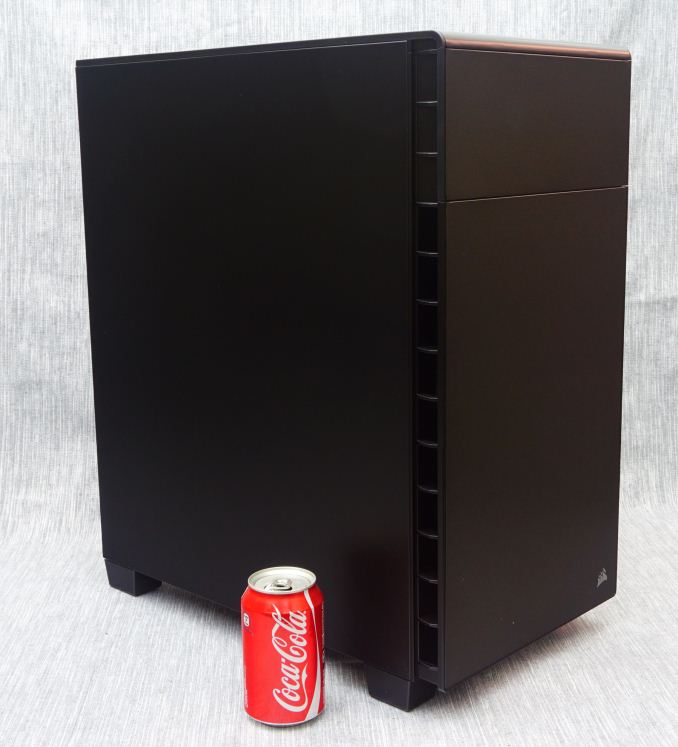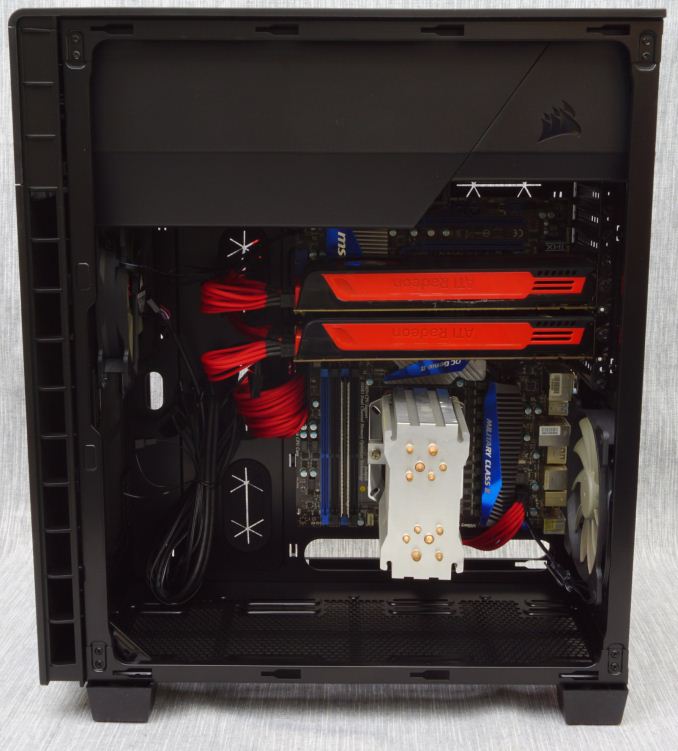The Corsair Carbide 600Q Case Review: Upside Down But Right On
by E. Fylladitakis on September 12, 2016 8:30 AM EST- Posted in
- Cases/Cooling/PSUs
- Corsair
- ATX
- E-ATX
Conclusion
Corsair added the Carbide 600Q to their ranks as a case with a minimalistic appearance and similarly minimalistic noise. Aesthetics are a highly subjective matter, so the minimalistic design of the case will probably be a bit polarizing; some will love the minimalistic, plain design, whereas others will be comparing it to a refrigerator. In terms of quality, the Carbide 600Q is an excellent product, built from high quality materials and with a very well designed, mechanically strong chassis.
Under the hood, the system area of the Carbide 600Q is roomy, offering excellent hardware compatibility and maintenance comfort. Aside from its stock cooling fans, the Carbide 600Q also offers a plethora of options for liquid cooling support. The case can support a radiator up to 280 mm long at the front of the case, up to 360 mm long at the bottom of the case, and up to 140 mm long at the rear of the case. This allows for various combinations of multiple all-in-one liquid coolers as well, such as, for example, one for the CPU installed to the bottom of the case and one for the GPU installed to the rear of the case.
However it should be noted that the Carbide 600Q is limited in terms of drives support, as the maximum number of drives that can be installed is relatively low. The majority of system builders should be satisfied with the number of drives that this case can support - two 3.5" drives and a trio of 2.5" SSDs - but it clearly was not designed for systems that require a large number of drives. Considering the mediocre thermal performance within the 3.5” drive area, the 3.5” slots are probably bsed used with low RPM/low power disks, such as efficient consumer-grade drives that have been designed with simple data storage in mind.
Perhaps the best feature of the case and one that seems that is not getting enough attention in the company’s marketing is its exceptional thermal performance. The Carbide 600Q, with a size comparable to most typical ATX designs, outperformed much larger cases that have been designed with thermal performance as their primary focus. The Carbide 600Q also has excellent noise reduction capabilities but, of course, Corsair’s marketing quote that the Carbide 600Q will always be whisper-quiet “no matter what’s running inside” is an exaggeration. Even our 44.2 dB(A) dummy load would still be unnervingly loud for users that seek to build a silent setup. A truly quiet system requires the careful selection of every component - the Carbide 600Q will help, but it definitely is unable to make a loud build suddenly go quiet.
In summary, Corsair designed the Carbide 600Q to entice advanced users that want a high quality and versatile case with excellent thermal performance and sound dampening capabilities but, at the same time, prefer a subtle and elegant appearance over a fancy design that instantly stands out. The Carbide 600Q excellently combines all of these features but, unsurprisingly, the designer could not keep the cost of such a product very low. With a retail price of $140, the Carbide 600Q is a relatively expensive product, but one that we would wholeheartedly recommend to users that require both excellent quality and overall performance from a product that they plan on keeping for years to come.












46 Comments
View All Comments
BrokenCrayons - Monday, September 12, 2016 - link
"Cleverly, the designer moved the PSU compartment to the top of the case..."My mid-1990s Packard Bell and and early 2000s eMachine are rolling over in their respective graves over the idea of a top-mounted PSU being considered a clever idea in 2016.
dsraa - Monday, September 12, 2016 - link
So am I, I hate that all the newer cases have the PS at the bottom for 'structural integerity' or some sh*t. It logically makes sense to put it at the top, and keep the mobo at the bottom, so that the front case fan can just blow air straight over it, to be grabbed by the rear case fan......so simple!!!TetsuoS2 - Monday, September 12, 2016 - link
It's not that simple, for cubes and large cases, like this, a top mounted psu is fine and dandy since the psu isn't likely to be heavier than the case, but a top-mounted psu makes cases top heavy, and that makes it easier to fall over. That is simply how center of gravity works.damianrobertjones - Monday, September 12, 2016 - link
...Then don't smash into your case or put it under the desk? The force required would most likely topple a case with the PSU at the bottom as well.smartthanyou - Monday, September 12, 2016 - link
Nope, you are wrong.Ancillas - Monday, September 12, 2016 - link
And all it takes is one kid running in a bit too fast...MadAd - Monday, September 12, 2016 - link
Well who needs a hulking great ATX case if its going to be empty? Of course itll be top heavy then. For someone who can actually fill it itll be much more stable.Generally tho, who cares if its the other way around if theres enough airflow room to sleep a cat left over in either design? Really sucks constantly seeing reviews for cases way too big for anyone without extensive water, 3+ video or a mini HDD datacentre going on.
AnnonymousCoward - Saturday, September 17, 2016 - link
> Well who needs a hulking great ATX case if its going to be empty?To fit a huge GPU, huge CPU cooler, and silent 140mm fans.
JoeyJoJo123 - Monday, September 12, 2016 - link
There's more to it than just having the front intake fans in-line with the CPU and exhaust fans.The biggest component to traditional aircooling PCs (as opposed to watercooled PCs) is the proximity of the fans to the hot parts in the builds, the CPU and GPU. This leads to cases like the FT02 still remaining as one of the best aircooling PC cases on the market, just because it comes with 3 thick 180cm fans in very close proximity to the GPU and CPU areas.
The PSU being top-mounted or bottom-mounted has little to do with the overall cooling performance of the case. Today, it just makes more sense to put the heavy PSU on the bottom of the case (so the case remains stable) and elevating the case up using rubber feet so the PSU can intake fresh air from near the ground, as opposed to sharing the warm exhaust air floating inside the case, and expecting the PSU to act as an extra exhaust outlet for excess heat in the case.
Even if you were to say that old-style cases were "better" designed, the intake fan (of which in many cases there was only one typically small fan, not multiple) the intake fans lost all their air pressure as it tried to get air past the hard drive cage area, and without that air pressure (lost due to obstacles and distance) the cooling performance degrades.
Cases in general have tradeoffs. Even with the FT02, the tradeoff is you're forced to have to get a full-tower sized case, with very tall "feet" to get fresh air from the ground, and an awkward top I/O plate that's annoying to remove whenever you want to plug something in, or looks bad if it's simply left off. Otherwise, it performs admirably. Modern cases balance these tradeoffs and are typically rather quiet and perform rather well, along with having good features for hiding excess PC build mess, such as elevated motherboard trays for routing power cables and rear-mounted SSDs, etc.
This case takes a different approach, so there's different tradeoffs, but I don't necessarily think it's any better than the traditional modern-style cases we have.
SunLord - Monday, September 12, 2016 - link
I love my FT02 I just wish Silverstone would make a true replacement for it even a tweaked version that removes 2 or 3 5.25" as 5 is a waste of space and raise up the current drive bays along with making it a little wider allowing for more spacing behind the motherboard tray. It would also be nice if they made the top cover bigger or less restrictive even as running 3 DP and 1 HDMI cable along with all of the other cables a high end system can have is annoying.